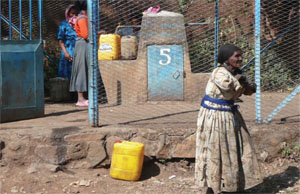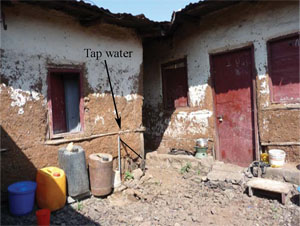
Water must be within safe physical reach, in or near the house, school or health facility. Accessibility to safe water can be classified as follows:
No access. You would say people do not have access to safe water when:
Basic access (see Figure 13.5). You would say people have a basic level of access to safe water when:

Intermediate access (see Figure 13.6). You would say people have an intermediate level of access to safe water when:

Optimal access. You would say people have optimal access to safe water when:
Earlier in this session it was said that the daily minimum water requirement was between 2 and 4.5 litres per person per day according to climate conditions. Why does this differ from any of the average consumption figures quoted above?
Because the average consumption refers to water used for all household purposes including washing, cooking and cleaning as well as drinking and eating. The requirement of 2 to 4.5 litres per person per day is the volume of water that must be consumed by a person to survive.